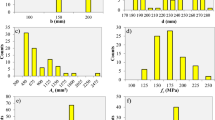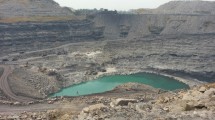Abstract
Uniaxial compressive strength (UCS) is a crucial mechanical parameter in the mining, construction, and petroleum industries. However, determination of the UCS is very tough, expensive, time-consuming, and destructive, requires expert workers for sample preparation, and cannot be determined in the field. As a result, prior researchers have employed different indirect proxy tests to estimate the UCS indirectly. Among these indirect tests, determining density (ρ) is the cheapest, simplest, non-destructive, and does not require sample preparation; also, ρ can easily be determined in the field. Therefore, the correlation between UCS and ρ has been rigorously studied in this paper. A total of 800 data points from 26 previous studies were incorporated and lithology based characteristic simple regression (SR) equations for six rock types (pyroclastic, sandstone, shale, carbonate, plutonic and volcanite) have been proposed. UCS can easily be estimated using the proposed regression equations for the six rock types, which will be helpful in geotechnical and geological engineering projects. The lithological control on the correlation for each rock type has also been validated using principal component analysis (PCA) and descriptive statistics. The obtained database was also used to classify the six rocks on the basis of UCS and ρ as per International Association of Engineering Geologist (IAEG) classification. Soft computing method of artificial neural network (ANN) was also used to estimate the UCS using two ANN models (ANN-1 and ANN-2). Finally, the estimated values of UCS from SR and ANN models were analysed in 1:1 measured vs. estimated plot and statistically assessed.












Similar content being viewed by others
Data availability
The authors declared that all the data generated or used during the study appear in the article.
References
Agustawijaya D (2007) The uniaxial compressive strength of soft rock. Civ Eng Dimens 9:9–14
Anikoh GA, Olaleye BM (2013) Estimation of strength properties of shale from some of its physical properties using developed mathematical models. Int J Eng Sci 2(4):1–5
ASTM (American Society of Testing and Materials) (2000) Standard test method for unconfined strength of intact rock core specimens. ASTM Standard D2938-95. West Conshohocken
Awang H, Naru NAM (2015) Predicting Uniaxial Compression Strength (UCS) using bulk density for kuala lumpur granite and limestone. In: Proceedings of the international civil and infrastructure engineering conference 2014, pp 557–566
Bar N, Barton N (2017) The Q-Slope method for rock slope engineering. Rock Mech Rock Eng 50(12):3307–3322. https://doi.org/10.1007/s00603-017-1305-0
Bieniawski ZT (1973) Engineering classification of jointed rock masses. Civ Eng S Afr 15:335–344
Broome S, Lee M (2018) Unconfined Compression Results on Core from Borehole U-15n#10, NNSS, in support of SPE, SAND2018-13773R
Chatterjee R, Mukhopadhyay M (2002) Petrophysical and geomechanical properties of rocks from the oilfields of the Krishna-Godavari and Cauvery basins, India. Bull Eng Geol Environ 61:169–178
Çobanoglu I, Çelik SB (2008) Estimation of uniaxial compressive strength from point load strength, Schmidt hardness and P-wave velocity. Bull Eng Geol Environ 67:491–498. https://doi.org/10.1007/s10064-008-0158-x
Commission of Engineering Geological Mapping of the IAEG (1979) Classification of rocks and soil for engineering geological mapping, part 1: rock and soil materials. Bull Int Assoc Eng Geol 19:364–371
Geological Society Engineering Group Working Party (1977) The description of rock masses for engineering purposes. report. Q J Eng Geol 10:43–52
Ghabousi J, Garret JH Jr, Wu X (1991) Knowledge-based modelling of material behaviour with neural networks. J Engng Mech ASCE 117(1):132–153
González J, Saldaña M, Arzúa J (2019) Analytical model for predicting the UCS from P-wave velocity, density, and porosity on saturated limestone. Appl Sci 9(23):5265
Ince I, Fener M (2016) A prediction model for uniaxial compressive strength of deteriorated pyroclastic rocks due to freezeethaw cycle. J Afr Earth Sci 120:134–140. https://doi.org/10.1016/j.jafrearsci.2016.05.001
International Society of Rock Mechanics (ISRM) (1979) Suggested methods for determining the uniaxial compressive strength and deformability of rock materials. Int J Rock Mech Min Sci Geomech Abstr 16:135–140
ISRM Commission on the Classification of Rocks and Rock Masses (1981) Basic geotechnical description of rock masses. Int J Rock Mech Min Sci Geomech Abstr 18:85–110
Kahraman S (2001) Evaluation of simple methods for assessing the uniaxial compressive strength of rock. Int J Rock Mech Min Sci 38:981–994
Kahraman S, Balcı C, Yazıcı S, Bilgin N (2000) Prediction of the penetration rate of rotary blast hole drills using a new drillability index. Int J Rock Mech Min Sci 37(5):729–743. https://doi.org/10.1016/S1365-1609(00)00007-1
Karakuş M, Kumral M, Kılıc O (2005) Predicting elastic properties of intact rocks from index tests using multiple regression modelling. Int J Rock Mech Min Sci 42:323–330
Khandelwal M, Singh TN (2009) Correlating static properties of coal measures rocks with P-wave velocity. Int J Coal Geol 79:55–60. https://doi.org/10.1016/j.coal.2009.01.004
Kurtulus C, Irmak TS, Sertcelik I (2010) Physical and mechanical properties of Gokceada: Imbros (NE Aegean Sea) Island andesites. Bull Eng Geol Environ 69:321–324
Kurtulus C, Cakir S, Yogurtcuoglu AC (2016) Ultrasound study of limestone rock physical and mechanical properties. Soil Mech Found Eng 52(6):348–354
Madhubabu N, Singh PK, Kainthola A, Mahanta B, Tripathy A, Singh TN (2016) Prediction of compressive strength and elastic modulus of carbonate rocks. Measurement 88:202–213. https://doi.org/10.1016/j.measurement.2016.03.050
Majeed Y, Bakar MA (2016) Statistical evaluation of CERCHAR Abrasivity Index (CAI) measurement methods and dependence on petrographic and mechanical properties of selected rocks of Pakistan. Bull Eng Geol Environ 75(3):1341–1360
Mishra DA, Basu A (2013) Estimation of uniaxial compressive strength of rock materials by index tests using regression analysis and fuzzy inference system. Eng Geol 160:54–68
Momeni E, Armaghani DJ, Hajihassani M, Amin MF (2015) Prediction of uniaxial compressive strength of rock samples using hybrid particle swarm optimisation-based artificial neural networks. Measurement 60:50–63
Moradian OZ, Behnia M (2009) Predicting the unconfined compressive strength and static young’s modulus of intact sedimentary rocks using the ultrasonic tests. Int J Geomech 9:1–14
Rahman T, Sarkar K (2021) Lithological control on the estimation of uniaxial compressive strength by the P-wave velocity using supervised and unsupervised learning. Rock Mech Rock Eng 54:3175–3191
Rahman T, Sarkar K (2022) Estimating strength parameters of Lower Gondwana coal measure rocks under dry and saturated conditions. J Earth Syst Sci. https://doi.org/10.1007/s12040-022-01920-2
Rahman T, Sarkar K (2023) Correlations between uniaxial compressive strength and dynamic elastic properties for six rock types. Int J Geomech. https://doi.org/10.1061/IJGNAI/GMENG-7854
Rahman T, Sarkar K, Singh AK (2020) Correlation of geomechanical and dynamic elastic properties with the P-wave velocity of Lower Gondwana coal measure rocks of India. Int J Geomech 20(10):04020189. https://doi.org/10.1061/(ASCE)GM.1943-5622.0001828
Romana M (1985) New adjustment ratings for application of Bieniawski classification to slopes. In: Proceedings of international symposium on role of rock mech. ISRM, Zacatecas, pp 49–53
Sarkar K, Tiwary A, Singh TN (2010) Estimation of strength parameters of rock using artificial neural networks. Bull Eng Geol Environ 69:599–606
Sarkar K, Vishal V, Singh TN (2012) An empirical correlation of index geomechanical parameters with the compressional wave velocity. Geotech Geol Eng 30:469–479
Sharma LK, Vishal V, Singh TN (2017) Developing novel models using neural networks and fuzzy systems for the prediction of strength of rocks from key geomechanical properties. Measurement 102:158–169
Singh TN, Dubey RK (2000) Study of transmission velocity of primary wave (P-wave) in coal measure sandstone. J Sci Ind Res 59:482–486
Singh VK, Singh D, Singh TN (2001) Prediction of strength properties of some schistose rocks from petrographic properties using artificial neural networks. Int J of Rock Mech Min Sci 38:269–284
Sousa LMO, Suárez del Rio LM, Calleja L, Ruiz de Argandoña VG, Rey AR (2005) Influence of microfractures and porosity on the physico-mechanical properties and weathering of ornamental granites. Eng Geol 77:153–168. https://doi.org/10.1016/j.enggeo.2004.10.001
Teymen A, Mengüç EC (2020) Comparative evaluation of different statistical tools for the prediction of uniaxial compressive strength of rocks. Int J Min Sci Technol 30(6):785–797. https://doi.org/10.1016/j.ijmst.2020.06.008
Tugrul A, Zarif IH (1999) Correlation of mineralogical and textural characteristics with engineering properties of selected granitic rocks from Turkey. Eng Geol 51:303–317. https://doi.org/10.1016/S0013-7952(98)00071-4
Wyering LD, Villeneuve MC, Wallis IC, Siratovich PA, Kennedy BM, Gravley DM, Cant JL (2014) Mechanical and physical properties of hydrothermally altered rocks, Taupo Volcanic Zone, New Zealand. J Volcanol Geotherm Res 288:76–93. https://doi.org/10.1016/j.jvolgeores.2014.10.008
Yagiz S (2011) P-wave velocity test for assessment of geotechnical properties of some rock materials. Bull Mater Sci 34(4):947–953
Yasar E, Erdogan Y (2004) Correlating sound velocity with the density, compressive strength and young’s modulus of carbonate rocks. Int J Rock Mech Min Sci 41:871–875. https://doi.org/10.1016/j.ijrmms.2004.01.0
Acknowledgements
The authors gratefully acknowledge IIT(ISM) Dhanbad. The authors would also like to thank the anonymous reviewers for their constructive suggestions.
Author information
Authors and Affiliations
Contributions
All authors contributed to the study conception and design. Material preparation, data collection and analysis were performed by Tabish Rahman. The first draft of the manuscript was written by Tabish Rahman, while Kripamoy Sarkar gave valuable suggestions and corrections. All authors read and approved the final manuscript.
Corresponding author
Ethics declarations
Competing interests
The authors declare no competing interests.
Additional information
Communicated by: H. Babaie
Publisher's note
Springer Nature remains neutral with regard to jurisdictional claims in published maps and institutional affiliations.
Rights and permissions
Springer Nature or its licensor (e.g. a society or other partner) holds exclusive rights to this article under a publishing agreement with the author(s) or other rightsholder(s); author self-archiving of the accepted manuscript version of this article is solely governed by the terms of such publishing agreement and applicable law.
About this article
Cite this article
Rahman, T., Sarkar, K. Empirical correlations between uniaxial compressive strength and density on the basis of lithology: implications from statistical and machine learning assessments. Earth Sci Inform 16, 1389–1403 (2023). https://doi.org/10.1007/s12145-023-00969-x
Received:
Accepted:
Published:
Issue Date:
DOI: https://doi.org/10.1007/s12145-023-00969-x




